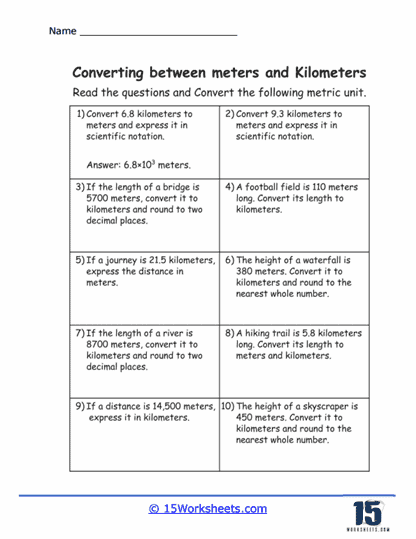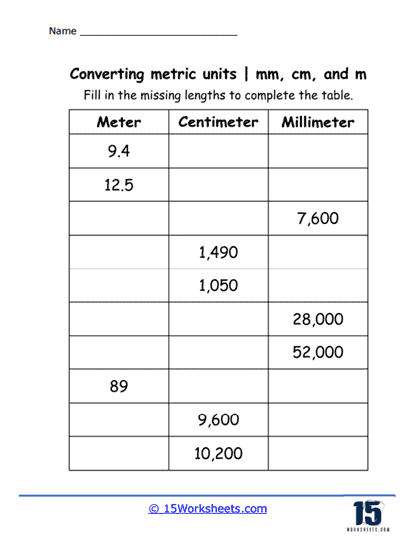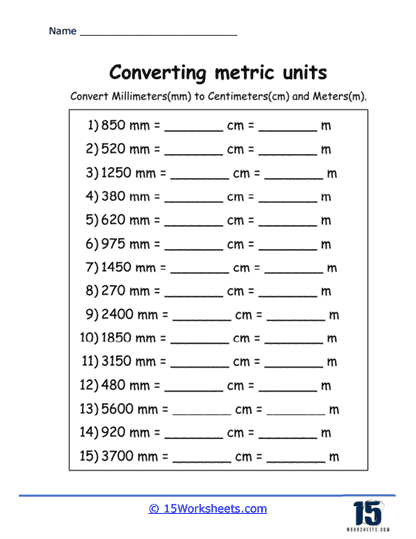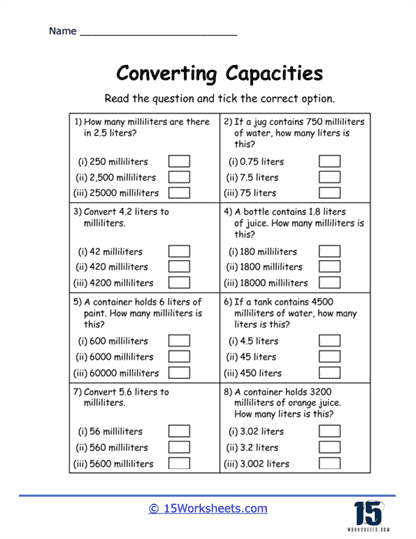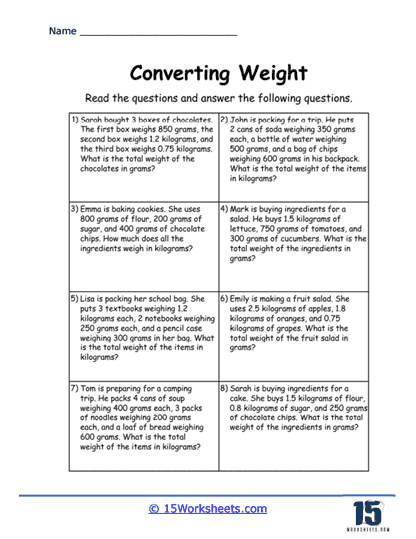Metric System Worksheets
About These 15 Worksheets
Our metric system worksheets were developed to teach students about the metric system, a decimal-based system of measurement used globally except in a few countries. These worksheets are commonly used in educational settings to help students understand and convert between different units of measurement such as meters, liters, and grams. The exercises provided on these worksheets are varied and structured to cater to different learning stages, ensuring that students can grasp the concepts at their own pace and apply them effectively in real-world scenarios.
Types of Problems
One common type of exercise found on metric system worksheets is the conversion practice. These exercises require students to convert between units within the same measurement system, such as converting centimeters to meters, grams to kilograms, or milliliters to liters. The goal is to help students become fluent in moving between smaller and larger units by multiplying or dividing by powers of ten, which is a fundamental aspect of the metric system. This not only enhances their mathematical skills but also prepares them for tasks that involve precise measurements, such as in science experiments or cooking.
Another type of exercise is comparison problems, where students are asked to compare different measurements using greater than, less than, or equal to signs. For example, students might determine whether 1500 milliliters is more than 1.5 liters or if 200 centimeters is less than 2 meters. These problems help students understand the relative sizes of metric units and their equivalences, reinforcing the decimal structure of the system and its simplicity for calculating and comparing quantities.
Word problems are also a staple in metric system worksheets. These problems present real-life scenarios where students must apply their knowledge of metric measurements to solve problems. For instance, a question might involve calculating the length of a room in meters if given the measurement in centimeters, or determining how many liters of water are needed to fill a container of a certain size. These exercises encourage students to apply their metric system knowledge contextually, enhancing their problem-solving and critical thinking skills.
Measurement activities, where students are given rulers, measuring cups, or scales, are another practical component of metric system worksheets. These activities require students to measure objects or quantities directly and record their observations using metric units. This hands-on approach helps students see and feel the measurements, making the abstract concepts more concrete and understandable. It also serves to familiarize them with metric tools such as metric rulers, which are typically marked in centimeters and millimeters, and metric scales, which measure grams and kilograms.
Estimation exercises are designed to develop students’ ability to approximate metric measurements without tools. For example, they might be asked to estimate the weight of a textbook in grams or the length of a desk in meters. This type of exercise cultivates a practical sense of scale and measurement, which can be critical in everyday life and certain professions where quick estimation is required.
Unit conversion tables are commonly included in metric system worksheets to serve as a reference tool. These tables often accompany exercises and help students learn to convert units across different measurement systems, such as from the metric system to the U.S. customary system. Learning to use these tables effectively can enhance students’ versatility in handling diverse measurement tasks, especially in international contexts.
Some metric system worksheets include matching exercises, where students match different quantities with the correct unit. For example, matching a list of measurements with the correct unit (like liters, meters, grams) helps reinforce recognition and understanding of when and where each unit is applicable.
In addition to these, advanced worksheets may incorporate scientific notation to express larger or smaller measurements. Exercises involving scientific notation require students to convert standard unit measurements into scientific notation, aiding in the comprehension of extremely large or small quantities used in higher mathematics and sciences.
Some metric system worksheets may integrate puzzles or games like crosswords or word finds that include terms related to metric measurement. These make learning more engaging and help in memorizing the terms associated with the metric system, such as “kilogram,” “decimeter,” or “milliliter.”
These worksheets can help students master a fundamental aspect of science and everyday life, ensuring they are well-prepared to use the metric system confidently and correctly. The exercises on these worksheets are designed to build a strong foundation in metric measurements through a variety of engaging and thought-provoking tasks.
The History Behind the Metric System
The metric system, formally known as the International System of Units (SI), represents a standardized method of measurement based on the decimal system, which simplifies the conversion between larger and smaller units by scaling up or down in powers of ten. The history of the metric system is a narrative of scientific advancement intertwined with political, economic, and educational reforms across the globe.
The metric system originated during the French Revolution in the late 18th century. Prior to its introduction, France, like many other countries, used a system of measurement that was considered chaotic because it varied by region and trade. The lack of standardization was problematic for commerce, science, and engineering. In 1791, the French Academy of Sciences was tasked with developing a new system that would be universal and based on a natural constant. The meter was defined as one ten-millionth of the distance from the North Pole to the Equator along the meridian through Paris. This new system was made compulsory in France by a law passed in 1795.
The simplicity and rationality of the metric system led to its adoption beyond France. By the mid-19th century, many countries in Europe and Latin America had begun to officially adopt the metric system. The Convention of the Meter was signed in Paris in 1875 by 17 nations, including the United States, establishing an international treaty for the uniformity of measurement. This treaty established the International Bureau of Weights and Measures (BIPM) in Sèvres, France, tasked with providing standards for the metric system which was further standardized as the International System of Units (SI) in 1960.
Countries Using the Metric System
Today, the metric system is used by almost every country in the world as the primary or sole system of measurement for most purposes. This includes all members of the United Nations except for the United States, Liberia, and Myanmar. However, even these countries use the metric system to some extent. For example, Myanmar has been in the process of official metrication since 2013.
The United States and the Metric System
Although the United States was one of the original signatories to the Metric Convention, it has yet to fully embrace the metric system. This reluctance can be attributed to several key factors.
Cultural and practical inertia plays a significant role. The U.S. has a long-standing system of customary units deeply ingrained in its cultural identity and everyday activities. This system is not only a matter of tradition but also heavily embedded in practical aspects of life, from cooking measurements to road signs. Transitioning to the metric system would require a massive overhaul that impacts various sectors including industries, education, and the general public. Such a shift demands a change in how people think and operate on a daily basis, which is a substantial challenge.
The economic cost of converting to the metric system is considerable. Industries such as construction, manufacturing, and retail would incur substantial expenses to modify equipment, update packaging, and alter processes. These costs extend to every level of production and service, presenting a formidable barrier to full metrication. The economic implications make businesses and policymakers wary of mandating such a widespread change.
Despite these challenges, there have been legislative attempts to encourage the adoption of the metric system in the U.S. The Metric Conversion Act of 1975 is a notable example, aiming to foster metrication. However, these efforts often lack the enforcement mechanisms necessary to ensure compliance, resulting in limited progress. Nonetheless, the metric system finds significant application in specific fields within the U.S. In science, medicine, military, and certain industrial sectors, the need for precision and international collaboration necessitates the use of the metric system, highlighting a partial adoption where it is most practical and essential.
Globally, the metric system’s rationality and simplicity have led to its near-universal adoption. However, achieving complete global uniformity remains a challenge, particularly for countries like the United States with entrenched customary systems. As a result, the U.S. operates under a dual system, utilizing both metric and customary units. This duality represents a compromise, balancing the need for international compatibility with the reality of domestic tradition and infrastructure. The coexistence of both systems reflects an ongoing negotiation between modern standardization and established practices.

